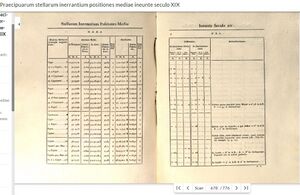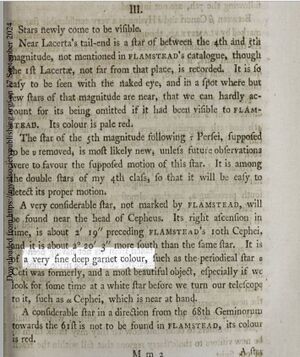Garnet Star
The name ‘garnet star’ was given by Piazzi with a reference to Wilhelm Herschel's textual description of μ Cephei (SIMBAD) as "deep garnet red". In telescopes the star appears red due to its spectral class M2. The star is visible to the naked eye, but the human eye cannot recognize the colour without a telescope because colour vision cuts off at roughly 2 mag.
μ Cephei is a semi-regular variable star, ranging between mags. 3.4 and 5.1, and was the prototype of the no-longer-used class of "mu Cephei stars". It is a red supergiant with an estimated diameter over a thousand times that of the Sun, one of the largest stars known.
Etymology and History
μ Cephei became famous through observations by Wilhelm Herschel (1738 - 1822), who described it in a paper[1] in 1783 listing stars that were not listed in Flamsteed's star catalogue.
A considerable star, not marked by Flamsteed, will be found near the head of Cepheus. Its right ascension ... It is of very deep garnet colour, such as the periodical star ο Ceti was formerly, and a most beautiful object, especially if we look for some time at a white star before we turn our telescope to it, such as α Cephei,which is near at hand.
(p. 257 under the headline "Stars newly come to be visible")

According to this description, Piazzi in his Palermo Star Catalogue[2] named it "Garnet Star". The description of mu Cephei as "deep red" evokes the image of a vividly red star. In fact, the star's color index (B – V) of 2.35 magnitudes makes it the reddest one visible for the naked eye (although the colour is only visible in telescopes). This intense hue is largely due to the interstellar dust between us and the star. Corresponding to its spectral type, without the reddening effect of this dust, its color index would be (B – V) = 1.71 magnitudes.
The star's variability is not mentioned by Herschel, but only suspected by J. R. Hind in 1848 and confirmed by Argelander. Like many red supergiants (e.g. Betelgeuse, Antares), the Garnet Star has two periods, one of 850 and another 4400 days, and it is (of course) surrounded by the nebula of its emissions.
IAU Working Group Star Names
In 2023, the WGSN discovered that SIMBAD has two proper names for the star, "Erakis" and "Herschel's Garnet Star", and decided to study their history. Which of the names should be preferred?
The Arabic reading group agreed that "Erakis" is a misspelling of "Alrakis", a name which is applied to another star already (in 2017, WGSN applied "Alrakis" to μ Dra with the reason by Kunitzsch and Smart that the star name had been misapplied to this star earlier). Therefore, the Arabic alternative should be dropped. We also suggest to use the shorter (and non-eponymous) version "Garnet Star".
The name "Garnet Star" was discussed and approved for μ Cephei by the IAU WGSN in 2024.
Weblinks
Reference
- ↑ Herschel, Wilhelm (1783). "On the Proper Motion of the Sun and Solar System; With an Account of Several Changes That Have Happened among the Fixed Stars since the Time of Mr. Flamstead [sic]". Philosophical Transactions of the Royal Society of London. 73: 247–283. doi:10.1098/rstl.1783.0017. JSTOR 106492. S2CID 186213288.
- ↑ Piazzi, Giuseppe (1803). Praecipuarum stellarum inerrantium positiones mediae ineunte seculo XIX : ex observationibus habitis in specula Panormitana ab anno 1792 ad annum 1802, OCLC: 643816777







